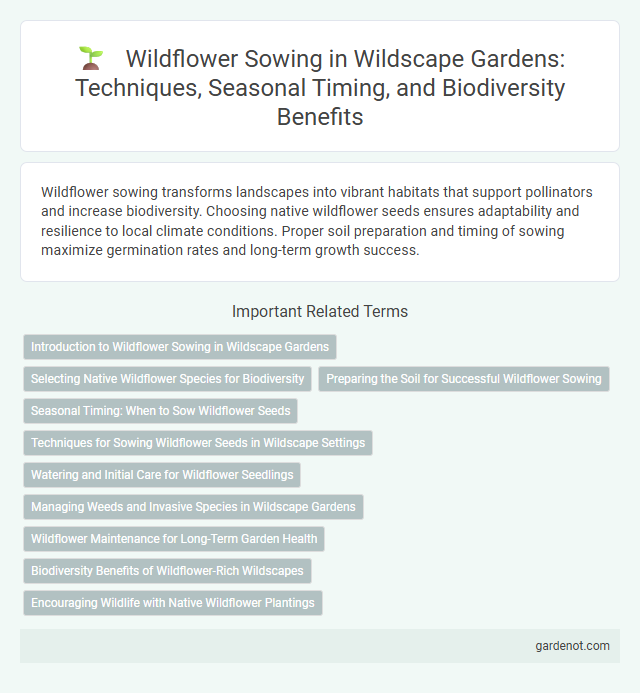Wildflower sowing transforms landscapes into vibrant habitats that support pollinators and increase biodiversity. Choosing native wildflower seeds ensures adaptability and resilience to local climate conditions. Proper soil preparation and timing of sowing maximize germination rates and long-term growth success.
Introduction to Wildflower Sowing in Wildscape Gardens
Wildflower sowing in Wildscape gardens enhances biodiversity by introducing native plant species that support pollinators and wildlife habitats. Selecting region-specific wildflower seeds ensures adaptability to local soil and climate conditions, promoting sustainable growth with minimal maintenance. Proper site preparation, including soil loosening and removal of competing vegetation, maximizes seed germination success and vibrant floral displays.
Selecting Native Wildflower Species for Biodiversity
Selecting native wildflower species enhances local biodiversity by providing essential habitats and food sources for pollinators such as bees, butterflies, and native birds. Native wildflowers are adapted to local soil, climate, and ecological conditions, ensuring higher survival rates and less maintenance compared to non-native species. Prioritizing a diverse mix of regional wildflower species supports ecosystem stability, improves soil health, and promotes sustainable wildlife populations within wildscape projects.
Preparing the Soil for Successful Wildflower Sowing
Preparing the soil for successful wildflower sowing involves clearing all existing vegetation and thoroughly loosening the top 15cm of soil to promote root penetration. Incorporating organic matter such as compost enhances soil fertility and improves moisture retention crucial for seed germination. Conducting a soil pH test and adjusting levels to neutral or slightly acidic (6.0-7.0) optimizes nutrient availability for diverse wildflower species.
Seasonal Timing: When to Sow Wildflower Seeds
Sow wildflower seeds in early spring or late autumn to optimize germination and establishment, taking advantage of natural temperature fluctuations and moisture levels. Timing seed sowing before rainfall ensures adequate soil moisture, promoting strong root development and reducing the need for supplemental watering. Seasonal timing aligns with species-specific growth cycles, enhancing biodiversity and supporting local pollinators effectively.
Techniques for Sowing Wildflower Seeds in Wildscape Settings
Effective techniques for sowing wildflower seeds in wildscape settings include preparing the soil by removing existing vegetation and lightly scarifying the surface to enhance seed-to-soil contact. Broadcasting seeds evenly over the area followed by gentle raking or rolling helps ensure proper seed placement and protects seeds from wind or birds. Timing sowing during early spring or autumn aligns with natural germination cycles, promoting vigorous growth and establishment of native wildflower species.
Watering and Initial Care for Wildflower Seedlings
Proper watering is crucial for wildflower seedling survival, requiring consistent moisture without waterlogging to encourage deep root development. Water seedlings gently in the early morning or late evening to reduce evaporation and fungal risks. Initial care involves monitoring soil moisture daily and protecting seedlings from heavy rain or strong winds to ensure robust growth.
Managing Weeds and Invasive Species in Wildscape Gardens
Effective management of weeds and invasive species in wildscape gardens involves regular monitoring and prompt identification to prevent their spread. Utilizing manual removal techniques and selective mulching helps suppress unwanted vegetation without harming native wildflowers. Integrating native plant species enhances ecological balance, promoting resilience against invasive species infiltration.
Wildflower Maintenance for Long-Term Garden Health
Wildflower maintenance is crucial for long-term garden health, involving regular weeding to prevent invasive species from overtaking native blooms. Seasonal mowing or cutting back wildflowers after their blooming cycle promotes healthy regrowth and supports soil fertility. Incorporating organic mulch and monitoring soil moisture levels ensures sustainable growth and vibrant wildflower displays year after year.
Biodiversity Benefits of Wildflower-Rich Wildscapes
Wildflower-rich wildscapes significantly enhance biodiversity by providing diverse habitats and food sources essential for pollinators such as bees, butterflies, and other beneficial insects. These wildflowers support ecosystem resilience by attracting a variety of wildlife, including birds and small mammals, which contribute to natural pest control and soil health. Establishing wildflower sowing areas promotes genetic diversity within plant communities, fostering a balanced and sustainable environment.
Encouraging Wildlife with Native Wildflower Plantings
Native wildflower plantings support local ecosystems by providing essential nectar and pollen sources for pollinators such as bees and butterflies. These wildflowers enhance biodiversity, creating habitats for birds, insects, and small mammals while improving soil health and water retention. Incorporating region-specific species ensures resilience against pests and climate variability, making wildflower sowing a sustainable strategy for encouraging wildlife.
Wildflower sowing Infographic

 gardenot.com
gardenot.com